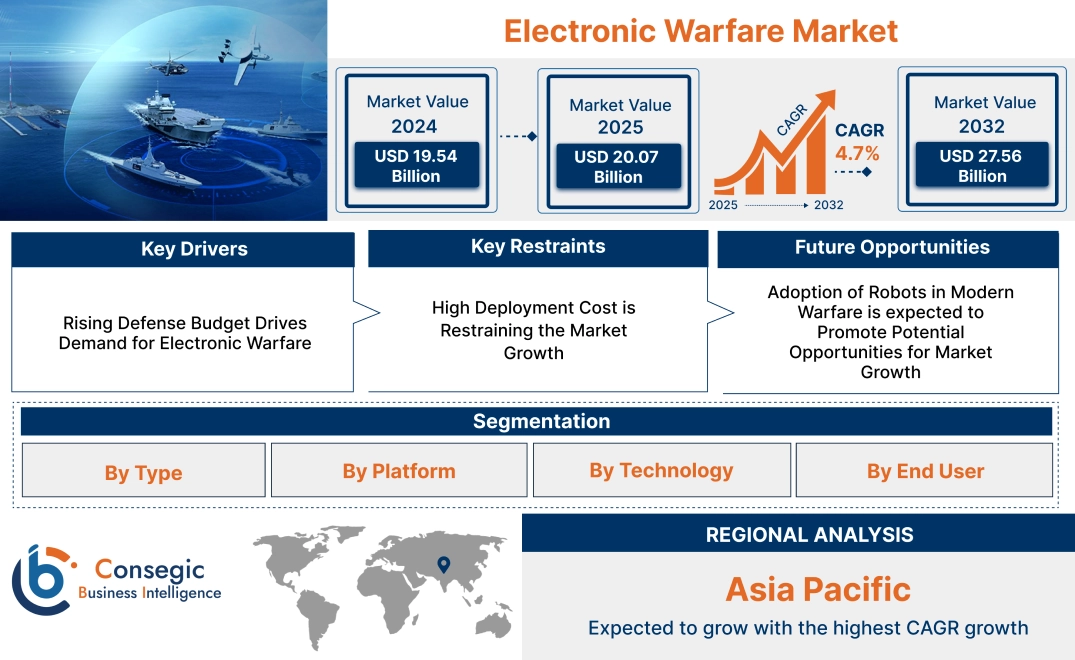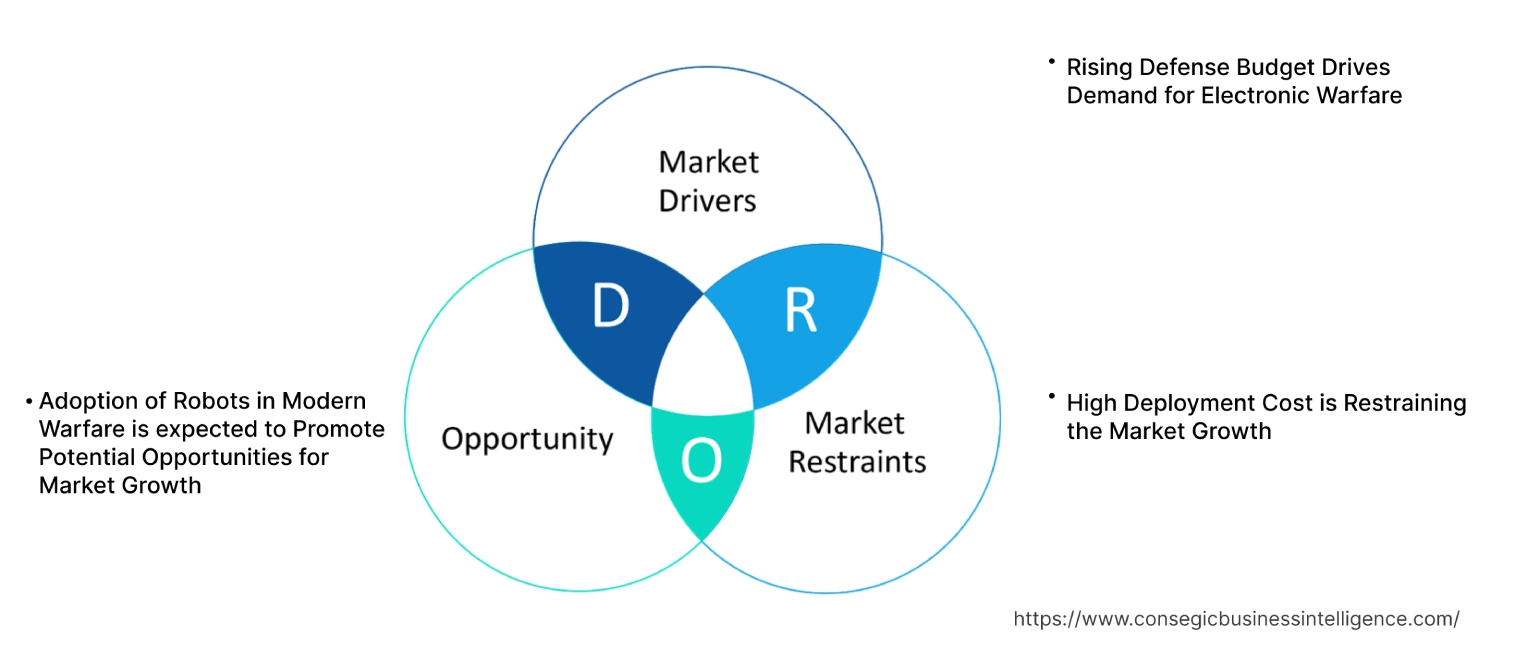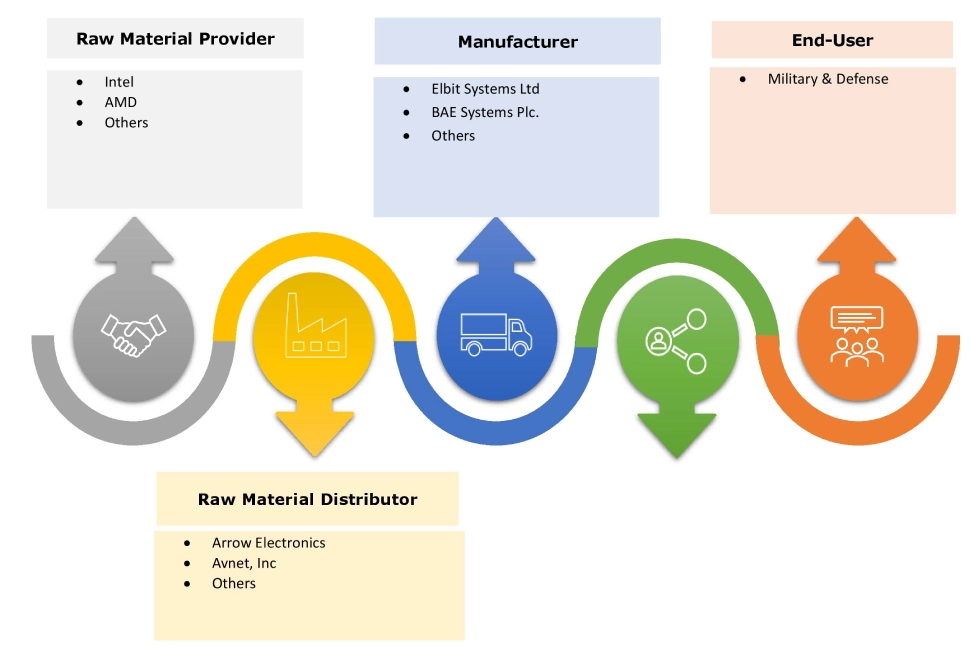- Summary
- Table Of Content
- Methodology
Electronic Warfare Market Size:
Electronic Warfare Market size is estimated to reach over USD 27.56 Billion by 2032 from a value of USD 19.54 Billion in 2024 and is projected to grow by USD 20.07 Billion in 2025, growing at a CAGR of 4.7% from 2025 to 2032.
Electronic Warfare Market Scope & Overview:
Electronic warfare involves the adoption of electronic systems and techniques to control activities such as jamming, deception, and electronic protection as well as providing aid in combat operations. The primary goal of electronic combat is to gain a tactical advantage over the enemy by disrupting or neutralizing their ability to communicate, detect or target friendly forces. Also, the advantages include enhanced situational awareness, improved communication, enhanced weapon system, and others are driving the electronic warfare market growth. Further, the increasing focus towards strengthening national defense industry is driving the electronic warfare market demand.
Key Drivers:
Rising Defense Budget Drives Demand for Electronic Warfare
The rapid modernization and development of defense services due to increasing defense budget is driving the electronic warfare market growth. Also, the growing emphasis on countermeasure capabilities is paving the way for modernization and development of defense services. Further, the increasing investment in the development of services and tools is driving the electronic warfare market demand.
- For instance, according to PIB, the Indian ministry of defense announced budget for modernization and infrastructure development of the defense services reached USD 1,626 Billion in FY2022-23 which is 57% rise since 2019-20.
Therefore, the growing defense budget is driving the adoption of electronic warfare, in turn proliferating the growth of the market.
Key Restraints:
High Deployment Cost is Restraining the Market Growth
The high deployment cost comprises of high development costs, complexity, and customization as well as increasing investment in the research and development is hindering the electronic warfare market expansion. Also, the complexity in development is time-consuming and expensive in turn restraining the market adoption.
Therefore, the high costs of manufacturing and deployment are restraining the electronic warfare market expansion.
Future Opportunities :
Adoption of Robots in Modern Warfare is expected to Promote Potential Opportunities for Market Growth
The rising adoption of military robots embedded with EW to keep the soldiers safe is driving the electronic warfare market opportunities. Additionally, the robots are utilized for search, track, and rescue operations as well as gathering intelligence and disrupt enemy communication is propelling the market adoption in modern warfare.
- For instance, in January 2025, L3Harris launched T7 robot inbuilt with advanced multirole electronic warfare. Additionally, the robot has the capability to detect un-crewed aircraft systems with the help of Individual CORVUS Node.
Hence, the rising adoption of robots is anticipated to increase the utilization, in turn promoting prospect for electronic warfare market opportunities during the forecast period.
Electronic Warfare Market Segmental Analysis :
By Type:
Based on the type, the market is segmented into electronic support, electronic protection, electronic attack, and others.
Trends in the Type:
- The AI integration with electronic support equipment for enabling faster and accurate signal processing is driving the electronic warfare market trend.
- The rising electronic threats and maintaining platform survivability are driving the adoption of electronic protection equipment which in turn fuels the electronic warfare market trend.
Electronic Attack accounted for the largest revenue share in the year 2024.
- Electronic attack is utilized to degrade, neutralize, or destroy an enemy's electronic systems and capabilities in turn driving the adoption in modern wars.
- Additionally, the rising investment in the research and development of electronic attack segment is boosting the electronic warfare market share.
- Further, the integration with air defense system and naval ships is driving the electronic attack segment which in turn drives the electronic warfare market size.
- For instance, in December 2024, Amentum received USD 105 million to support NSWC Crane, and airborne electronic attack systems division to develop electromagnetic warfare, ISR mission and survivability systems.
- Thus, as per the market analysis, rising investment in the defense systems is driving the electronic attack segment.
Electronic Protection is anticipated to register the fastest CAGR during the forecast period.
- The electronic protection refers to safeguarding personnel, equipment, and facilities against the effects of electronic attacks.
- Additionally, the increasing demand for detecting, analyzing, and initiating responses to threats is boosting the electronic warfare market share.
- Further, the rising adoption of protection equipment in military vehicles, ground stations combat aircraft, military helicopters and others in turn fuels the electronic warfare market size.
- Therefore, according to the electronic warfare market analysis, the increasing demand for detecting, analyzing, and initiating responses to threats are anticipated to boost the market during the forecast period.
By Platform:
Based on the platform, the market is segmented into aircraft, weapon, naval ship, vehicle, and others.
Trends in the Platform:
- The trend towards advancing ground tactical electronic support is driving the adoption of the system in vehicle platforms.
- The trend towards adoption of autonomous ships equipped with advanced artificial intelligence and machine learning algorithms is driving the market progress.
Aircraft accounted for the largest revenue share in the market in 2024.
- The aircrafts are specialized military planes designed to disrupt enemy radar and communication systems with the help of jamming and other techniques.
- Additionally, the rising adoption of unmanned aerial vehicles is driving the market development.
- Further, the need to protect aircraft from infrared-homing missiles is driving the electronic warfare industry.
- For instance, in February 2025, L3Harris Technologies completed first flight of viper shield electronic warfare system installed on Block 70 F-16 at California.
- Thus, as per the market analysis, rising adoption of unmanned aerial vehicles is driving the market progress.
Naval Ship is anticipated to register the fastest CAGR during the forecast period.
- The systems are mainly integrated into navy warships and submarines for protection against naval threats.
- Further, the rising maritime disputes between various countries and growing investment in advancing naval defense system is driving the market adoption.
- Therefore, according to the electronic warfare market analysis, the rising maritime disputes are anticipated to boost the market during the forecast period.
By Technology:
Based on the technology, the market is segmented into antennas, anti-jam electronic protection system, directed energy weapon, IR missile warning system, optical attack solutions, and others.
Trends in the Technology:
- The trend towards rising need for navigation and communication systems is driving the adoption of anti-jam electronic protection system.
Antennas accounted for the largest revenue share in the market in 2024.
- Antennas provide superior performance, and efficiency for protection of high value assets such as aircraft and ships are fueling the market progress.
- Additionally, the rising adoption of ultra-wideband omni and directional antennas which are designed for soldiers, ships, vehicles, and others.
- Further, the rising demand for compact, versatile, and rugged antenna technology is driving the market progress.
- For instance, in March 2025, Fractal Antenna Systems, Inc. launched miniaturized drone antenna designed for jamming of drone swarms.
- Thus, as per the market analysis, rising adoption of ultra-wideband omni and directional antennas is driving the market development.
Directed Energy Weapon is anticipated to register the fastest CAGR during the forecast period.
- The directed energy weapons are utilized for national defense, homeland security and law enforcement. Also, the weapon has both long and short range capabilities to counter threats ranging from ballistic, missiles, and others.
- Further, the increasing investment in directed energy technologies and rising research and development related to directed energy weapons is driving the growth of segment.
- Therefore, as per the market analysis, increasing investment as well as rising research and development are anticipated to boost the market during the forecast period.
By End-User:
Based on the end user, the market is segmented into land force, air, and naval.
Trends in the End User:
- The trend towards AI integration to enhance the jamming capabilities in aircrafts is driving the market progress.
- The rising adoption of cognitive systems which autonomously analyze unfamiliar signals is driving the market progress.
Land Force accounted for the largest revenue share of 58.09% in the year 2024.
- The rising need for electronic protection capabilities in militaries is propelling the market.
- Additionally, the rise of software-defined radios as well as miniaturization of systems is boosting the market progress.
- Further, the rising deployment of the system in land-based military platforms is driving the progress of segment.
- Thus, as per the market analysis, need for electronic protection capabilities is driving the market adoption by land forces.
Naval is anticipated to register the fastest CAGR during the forecast period.
- Naval ships are increasingly focusing towards areas of communications, surveillance radar as well as advancing military signal intelligence platforms in turn propelling the adoption of system.
- Further, the increasing focus towards advancing ship's defense capabilities is driving the market adoption.
- For instance, in March 2025, Rafael advanced defense systems ltd. partnered with elbit systems ltd. for the deployment of CMDS which is an advanced maritime EW solution. The solution is designed to counter missile attacks.
- Therefore, as per the market analysis, the increasing focus towards advancing ship's defense capabilities are anticipated to boost the market during the forecast period.
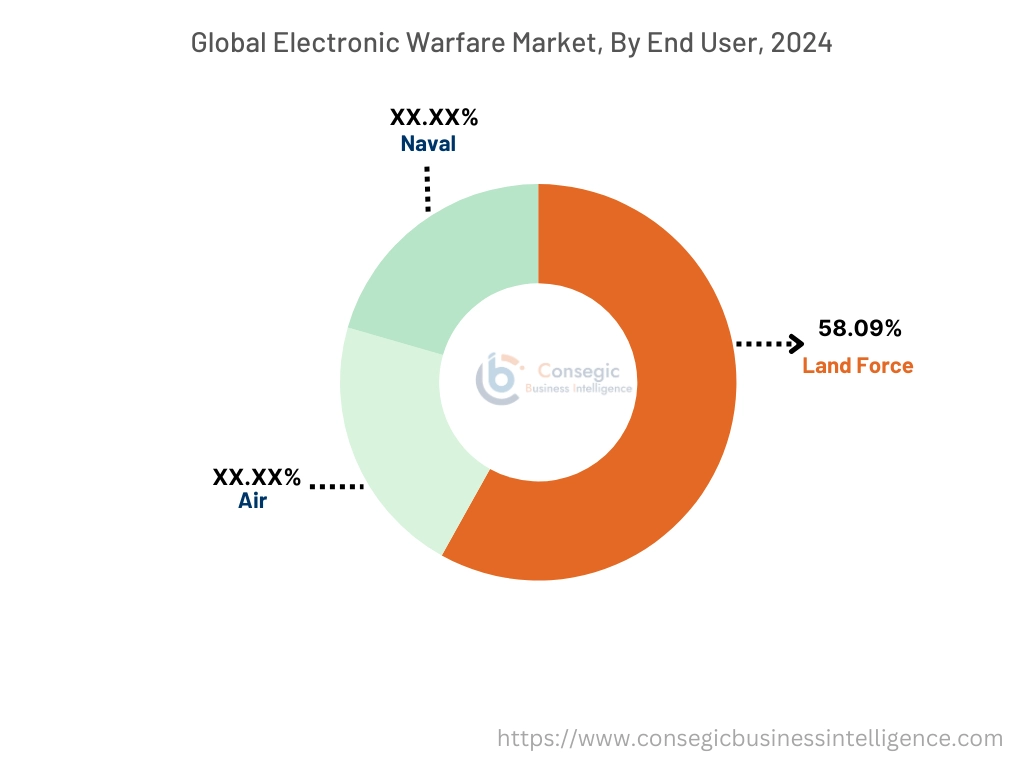
Regional Analysis:
The regions covered are North America, Europe, Asia Pacific, the Middle East and Africa, and Latin America.
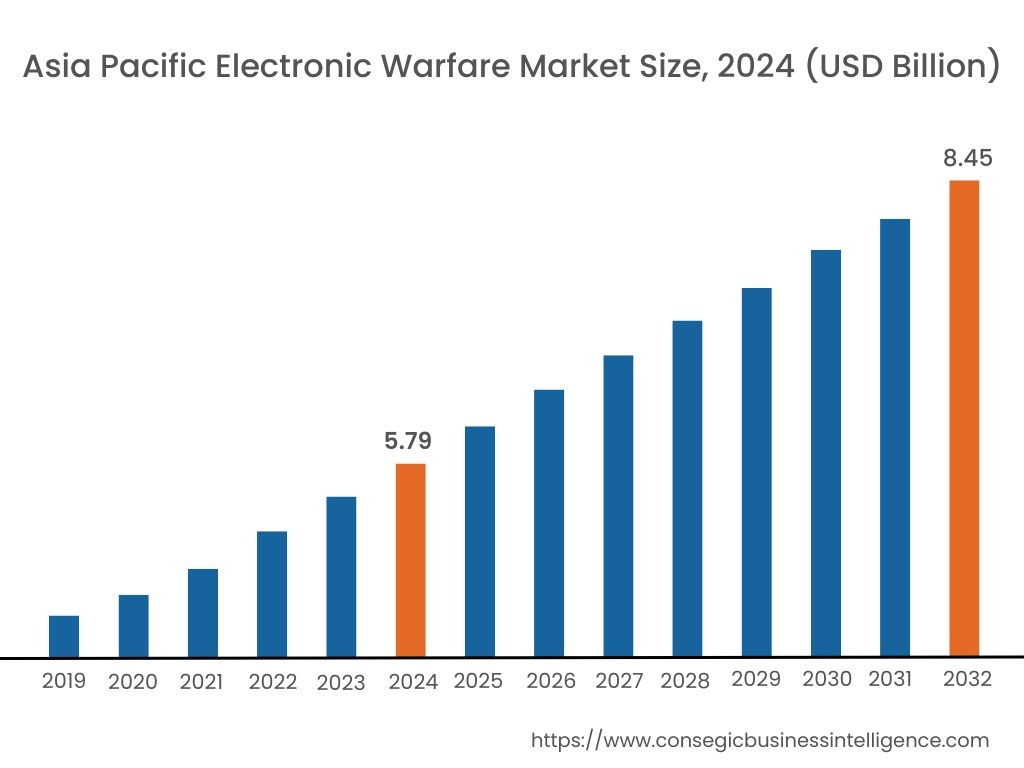
Asia Pacific region was valued at USD 5.79 Billion in 2024. Moreover, it is projected to grow by USD 5.97 Billion in 2025 and reach over USD 8.45 Billion by 2032. Out of this, China accounted for the maximum revenue share of 36.54%. The market is mainly driven by increasing defense budget and increased training capabilities across countries. Furthermore, factors including increasing border conflicts as well as rising adoption of advanced modern warfare are projected to drive the market progress in Asia Pacific region during the forecast period.
- For instance, in September 2022, Elbit Systems Ltd. received contract of USD 76 million for the supply of EW training capability to the country in Asia Pacific.
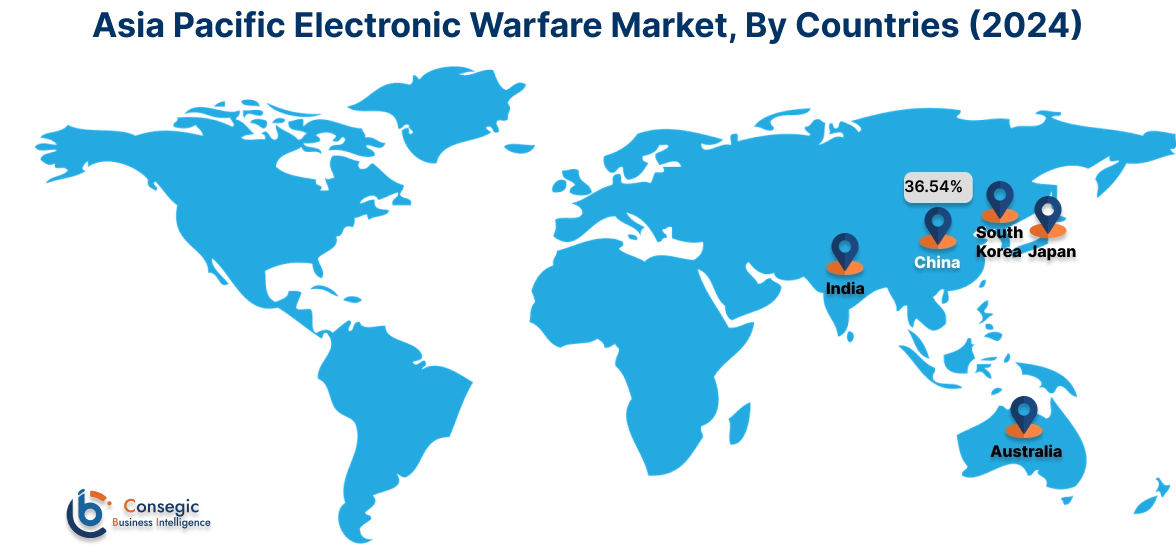
North America is estimated to reach over USD 9.69 Billion by 2032 from a value of USD 6.90 Billion in 2024 and is projected to grow by USD 7.09 Billion in 2025. The North American region's growing investment in the development and deployment of modern warfare capabilities offer lucrative growth prospects for the market. Additionally, the increasing focus towards advancing air-based systems is driving the market progress.
- For instance, in March 2025, CACI International Inc collaborated with United States Military Academy for the research and development of advanced EW technologies.
The regional evaluation depicts that the rising border conflicts as well as rising adoption of unmanned aerial vehicles is driving the market in Europe. Additionally, the key factor driving the market is growing regional conflicts as well as rising adoption of drones in modern wars is propelling the market adoption in the Middle East and African region. Further, the increasing focus towards modernization as well as rising cyber threats is paving the way for the progress of market in Latin America region.
Top Key Players and Market Share Insights:
The global electronic warfare market is highly competitive with major players providing technology to the national and international markets. Key players are adopting several strategies in research and development (R&D), product innovation, and end user launches to hold a strong position in the electronic warfare industry. Key players in the electronic warfare market include-
- Thales Group (France)
- Raytheon Technologies Corporation (U.S.)
- Northrop Grumman Corporation (U.S.)
- Moog Inc. (U.S.)
- Lockheed Martin Corporation (U.S.)
- Leonardo SPA (Italy)
- L3Harris Technologies Inc. (U.S.)
- General Dynamics Corporation (U.S.)
- Elbit Systems Ltd (Israel)
- BAE Systems Plc. (U.S.)
Recent Industry Developments :
Contracts:
- In April 2025, SwRI received a contract of USD 6.4 million from the U.S. Air Force for research and development of cognitive EW algorithms. The contract aims to enhance capabilities and protect aircrews.
- In February 2025, V2X Inc. received a contract of USD 21 million from the U.S. Air Force to sustain critical avionics and EW systems as well as repair and maintenance of crucial components.
Electronic Warfare Market Report Insights :
| Report Attributes | Report Details |
| Study Timeline | 2019-2032 |
| Market Size in 2032 | USD 27.56 Billion |
| CAGR (2025-2032) | 4.7% |
| By Type |
|
| By Platform |
|
| By Technology |
|
| By End-User |
|
| By Region |
|
| Key Players |
|
| North America | U.S. Canada Mexico |
| Europe | U.K. Germany France Spain Italy Russia Benelux Rest of Europe |
| APAC | China South Korea Japan India Australia ASEAN Rest of Asia-Pacific |
| Middle East and Africa | GCC Turkey South Africa Rest of MEA |
| LATAM | Brazil Argentina Chile Rest of LATAM |
| Report Coverage |
|
Key Questions Answered in the Report
How big is the electronic warfare market? +
The electronic warfare market size is estimated to reach over USD 27.56 billion by 2032 from a value of USD 19.54 billion in 2024 and is projected to grow by USD 20.07 billion in 2025, growing at a CAGR of 4.7% from 2025 to 2032.
What specific segmentation details are covered in the electronic warfare report? +
The electronic warfare report includes specific segmentation details for type, platform, technology, end user, and regions.
Which is the fastest segment anticipated to impact the market growth? +
In the electronic warfare market, the naval ship is the fastest-growing segment during the forecast period due to rising maritime disputes between various countries and growing investment in advancing naval defense systems.
Who are the major players in the electronic warfare market? +
The key participants in the electronic warfare market are Thales Group (France), Raytheon Technologies Corporation (U.S.), Northrop Grumman Corporation (U.S.), Moog Inc. (U.S.), Lockheed Martin Corporation (U.S.), Leonardo SPA (Italy), L3Harris Technologies Inc. (U.S.), General Dynamics Corporation (U.S.), Elbit Systems Ltd (Israel), BAE Systems Plc. (U.S.) and others.
What are the key trends in the electronic warfare market? +
The electronic warfare market is being shaped by several key trends including trend towards advancing ground tactical electronic support as well as adoption of autonomous ships equipped with advanced artificial intelligence and machine learning algorithms and others are the key trends driving the market.
